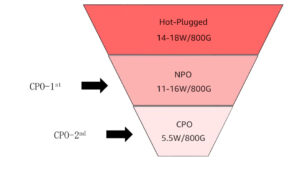In 2019, optical modules or optical engines and switching chips are “co-packaged” on a single substrate called co-packaged optics(CPO).
In 2022, some manufacturers, such as Broadcom, called CPO1.0 and 2.0 NPO and CPO respectively. NPO stands for near packaged optics. So some manufacturers classify NPO into CPO.

None of them belong to the OBO, Optics on Board, where the switch chip and the optical engine are connected through that large PCB on the switch.

The reason why CPO/NPO is not interconnected through the PCB on the motherboard is mainly for the consideration of performance and cost. If for its good performance to replace this large PCB board RF substrate, because of the large area and lead to high cost. There is only a small area where high-frequency signals need to be wired and interconnected, which is not worth it.
But if you use as usual with a cheap PCB, the loss of electrical signal interconnection is too large, the whole plate power increases, or the frequency of electrical signal can not go up.
NPO/CPO is to solve this problem by using a small piece of high-value RF substrate as the co-package of the switch chip and the light engine, which is convenient to reduce the high-frequency loss of electrical signals.
First, it was called CPO first generation, second generation, third generation, and then NPO/CPO.
There are major differences between NPO and CPO.
NPO: The ASIC chip of its switch is packaged, which contains Die and ASIC packaging substrate. The optical engine is also packaged, with a complete photoelectric signal processing process.
This is the concept of early CPO. At this time, DSP is still needed, so the engine power provided by Broadcom’s NPO is 11-16W/800G.

In the later stage, CPO can be evolved to remove the outer package of the independently packaged switch chip and directly connect the part of the optical engine with Die. The optical engine can be a packaged module or a complete chip packaged in multi-Die 3D(silicon photonics chip/electrical chip/some including laser).

The CPO power consumption of 5.5W/800G given by Broadcom, compared with NPO power consumption, is calculated after cutting off DSP power consumption.
